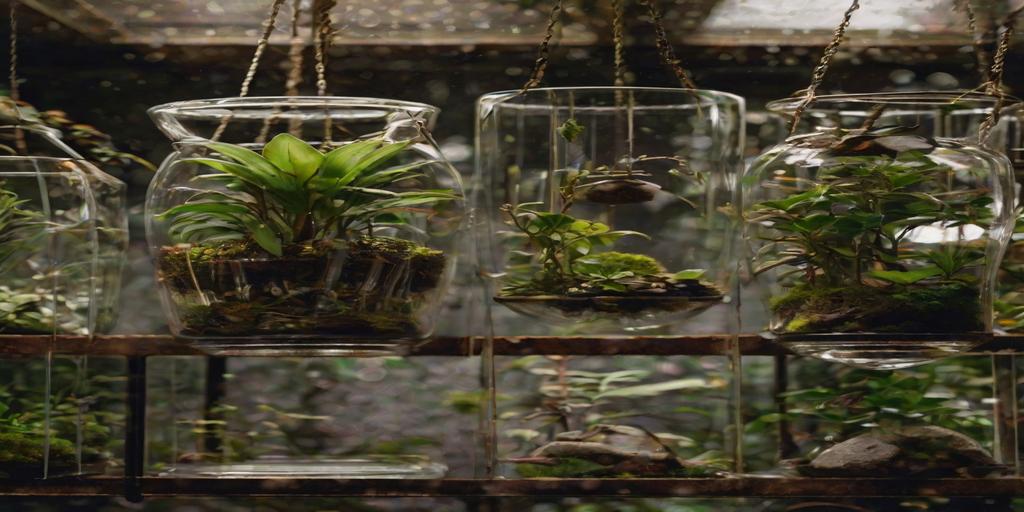
DIY Terrarium Ideas for Low Light Hanging Plants: Creative & Easy Designs
Discover stunning DIY terrarium ideas for low-light hanging plants! Learn how to create beautiful, low-maintenance hanging terrariums with shade-loving plants—perfect for any indoor space.
Introduction
Did you know that terrariums can thrive even in low-light conditions? If you love greenery but lack bright spaces, hanging terrariums with shade-tolerant plants are the perfect solution! Whether you’re a beginner or a plant enthusiast, this guide will walk you through creative, easy-to-make terrarium designs that add a touch of nature to your home. From choosing the right plants to styling tips, let’s dive into the world of low-light hanging terrariums!
Why Choose Low Light Hanging Terrariums?
Hanging terrariums are a fantastic way to bring greenery into spaces that don’t get much natural light. Unlike traditional houseplants that require bright, indirect sunlight, low light terrariums thrive in dimmer conditions—making them perfect for apartments with small windows, office spaces with fluorescent lighting, or even bathrooms with minimal sunlight.
One of the biggest advantages of low light terrariums is their low-maintenance nature. Many of the plants suited for these environments grow slowly, meaning they don’t need frequent pruning or repotting. Plus, the enclosed or semi-enclosed design of terrariums helps retain moisture, reducing the need for constant watering. If you love plants but don’t have the time (or ideal lighting conditions) for high-maintenance varieties, a hanging terrarium is a great solution.
Best Low Light Plants for Hanging Terrariums
Not all plants can thrive in low light, but several species are perfectly suited for hanging terrariums. Here are some of the best options:
Ferns
Ferns are a classic choice for terrariums because they love humidity and don’t need direct sunlight. The Maidenhair Fern adds delicate, lacy foliage, while the Bird’s Nest Fern offers broader, wavy leaves for a bolder look.
Vines
Trailing plants like Pothos and Philodendron are excellent for hanging terrariums. Their long vines can drape beautifully over the edges, creating a lush, cascading effect. Plus, they’re incredibly forgiving if you forget to water them occasionally.
Mosses
Mosses such as Sheet Moss and Mood Moss thrive in low light and add a soft, carpet-like texture to terrariums. They’re perfect for creating a forest-floor aesthetic and require very little upkeep.
Air Plants (Tillandsia)
Certain Tillandsia varieties can tolerate low light, making them a unique addition to hanging terrariums. Since they don’t need soil, they’re great for open terrarium designs where you want a minimalist, floating effect.
Essential Supplies for DIY Hanging Terrariums
Before you start building your terrarium, you’ll need a few key supplies:
Glass Containers
Choose a container that suits your style—geometric shapes, orbs, or teardrops are popular for hanging terrariums. Clear glass works best since it allows light to reach the plants from all angles.
Hanging Mechanisms
Depending on your decor, you can use macramé hangers, chains, or hooks to suspend your terrarium. Make sure the hanging method is sturdy enough to support the weight of the glass and plants.
Substrate Layers
A well-draining base is crucial. Start with pebbles or gravel for drainage, followed by activated charcoal to prevent mold, and then a layer of potting soil suitable for your chosen plants.
Decorative Elements
Personalize your terrarium with sand, small stones, or mini figurines. These touches can turn a simple terrarium into a tiny, enchanting world.
Step-by-Step Guide to Building Your Terrarium
Creating a hanging terrarium is simple if you follow these steps:
Step 1: Choose the Right Container
Pick a glass vessel that fits your space and plant selection. Open terrariums work well for air plants and succulents, while closed terrariums are better for moisture-loving ferns and mosses.
Step 2: Layer Drainage Materials
Add a thin layer of pebbles at the bottom for drainage, followed by activated charcoal to keep the environment fresh. This prevents waterlogging and mold growth.
Step 3: Add Soil and Arrange Plants
Place a layer of well-draining potting mix on top of the charcoal. Then, gently arrange your plants, starting with the largest and filling in with smaller ones. Leave enough space for growth.
Step 4: Secure the Terrarium for Hanging
Once your plants are in place, attach your chosen hanging mechanism carefully. Test the stability before hanging it in your desired spot.
Creative Design Ideas for Hanging Terrariums
If you want your terrarium to stand out, try one of these design styles:
Minimalist Style
A single air plant or small fern in a clear glass orb creates a sleek, modern look. This works well in contemporary spaces where less is more.
Fairy Garden
Add tiny figurines, miniature bridges, or tiny mushrooms to your terrarium for a whimsical fairy garden effect. Pair them with moss and small ferns for an enchanted forest vibe.
Tiered Hanging Setup
Suspend multiple terrariums at different heights using a single hook or a cascading macramé hanger. This adds depth and visual interest to any room.
Care Tips for Low Light Terrariums
Keeping your terrarium healthy doesn’t require much effort, but a few key practices will help it thrive:
Watering Frequency
Closed terrariums rarely need watering—condensation will recycle moisture. Open terrariums may need a light misting or watering every 1-2 weeks, depending on humidity levels.
Preventing Mold and Overgrowth
Too much moisture can lead to mold. If you notice condensation building up excessively, leave the terrarium open for a few hours to air out. Trim overgrown plants to maintain balance.
Pruning and Maintenance
Remove yellowing leaves and trim back vines or moss that grows too aggressively. A quick wipe of the glass with a damp cloth will keep your terrarium looking crystal clear.
By following these guidelines, you can enjoy a beautiful, low-maintenance hanging terrarium that thrives even in the dimmest corners of your home.
Conclusion
Hanging terrariums with low-light plants are a fantastic way to bring nature indoors—even in the darkest corners! With the right plants, containers, and care, you can create a stunning, self-sustaining display. Ready to start your DIY terrarium project? Pick your favorite design and let your creativity grow!
